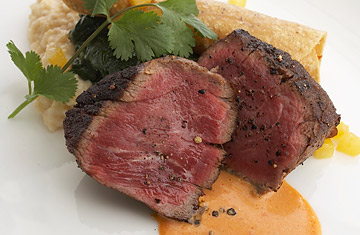
The quintessential postcrash luxury restaurant might well be Fearing's, at the Dallas Ritz-Carlton. From its local-sourced oak paneling to its haute-casual menu mentality, it's the zeitgeist restaurant par excellence. In a way, it was inevitable. White-tablecloth fine dining never really seemed to go with the Lone Star State's rugged self-image. People in Dallas love to eat out, and to eat out expensively; they just hate wearing jackets and going through the old feudal motions. A haute-casual restaurant there was bound to happen sooner or later. And the perfect man to do it was Dean Fearing, who formerly personified the high Texas style, back when the money was still rolling in.
Fearing, hailed by some as the "father of southwestern cuisine," pioneered a certain style of high-end regional cooking in the late 1980s that has since become old hat: the fusion of traditional luxe ingredients (lobster, foie gras, quail, filet mignon) with potent local flavors and produce (jicama, tomatillos, mesquite). The main proteins, though familiar, spelled class, and the flavor components provided the bold and explosive flavors needed by the kind of diner who pays to be surprised. That the dishes tended to be beautiful, even sculptural in that '80s way, only added to their allure. Fearing was the consummate American regional celebrity chef, from his immaculate pressed whites down to his hand-tooled Lucchese cowboy boots. He walked the walk and talked the talk, and his restaurant, the Mansion on Turtle Creek, was the place you had to go if you had money in Dallas. And there was a lot of money in Dallas.
Like many of his emulators, though, Fearing in the past few years has seen the writing on the wall, and noted the high-casual style being glorified by diners and critics on both coasts. In a bold stroke, he left the Mansion in 2007 when the Ritz-Carlton came calling with an offer he couldn't refuse. The hotel wanted him to create a signature restaurant from scratch, and provided what appears to have been a Pentagon-sized budget to create his new restaurant, called Fearing's. The result was an immediate success: the place won Esquire's Best New Restaurant of the Year, and topped the national Zagat rankings of hotel restaurants in 2008.
Fearing's is the very picture of the new luxe-casual restaurant. It caters to the same high-spending big-bucks clientele as did the Mansion; at Fearing's, however, they lean against the backlit honey-onyx walls and faux-rattlesnake-leather bar and drink Shiner Bocks in rolled-sleeve oxford shirts. "From the Mansion, the approach was to be expensive," Fearing says. "We're not looking to do that here." Or at least, not exclusively. The new postbubble haute cuisine, of which Fearing's is the perfect representative, would rather have a steady stream of customers in and out, seven days a week. "We want this place to be fun and approachable, things you can eat every day," Fearing told me.
His original high-low calculation at the Mansion was, it seems to me, more gestural than anything else — as if the mere act of putting jalapeños with sushi tuna, say, or dusting sweetbread with barbecue rub took away from the fact that you were at a special-occasion restaurant. Even in Turtle Creek, the swanky Dallas neighborhood that gave the place its name, I'm betting the people didn't eat at the Mansion on an average Tuesday after work.
Fearing's, like all the new big-hotel restaurants, is geared to accommodate as many ways of eating as humanly possible: bar grazing, breakfast, late-night snacks, private dinners in a frosted-glass 12-seat wine room fit for an Exxon board banquet. "I wanted to create a lot of environments," Fearing says, walking around one enormous area after another, all decorated by Texan artists and all studiously unstuffy. The elegant chandeliers are, on closer examination, made of rawhide; what seems to be filet mignon and risotto on neighboring tables is buffalo and grits, with a butternut-squash taquito that alone was worth the trip. The food is playful, but it's looser, since there's not such a heavy burden on conspicuous luxury. When I had dinner there last month on my father-in-law's dime, the dessert of fried lemon pies and blueberry cobbler was like the best Texas diner dessert of all time; a braised-buffalo nacho (Fearing is on a big buffalo kick these days) was something you would eat at a Hooters in guy heaven.
Meanwhile, Fearing is free to change up the leased space, close it, redefine the concept, whatever he wants — and who knows when he may have to? In the same way that the local grandees can stop in to drink a beer at his Rattlesnake Bar and then change, come back and have an anniversary dinner, Fearing's aims to be all things to all people — at least to all people with money. He has evolved his style after 20 years of settled stardom, and it seems to be working.
A restaurant like this requires a ton of money, media play such as only a major celebrity chef can garner, and a crowd-pleasing mandate that can be restrictive in the long run. I miss the theater and the gravity and the Alba truffles of the old white-tablecloth temples, whatever their name or region. But, like rhymed couplets and hemi-powered muscle cars, they've become antiques in their own time, before our very eyes, and Dean Fearing, at least, doesn't aim to join them.
Josh Ozersky is a James Beard Award—winning food writer and the author of The Hamburger: A History. His food video site, Ozersky.TV, is updated daily. He is currently at work on a biography of Colonel Sanders.
